Pasta with Garlic and Oil Recipe, also called Aglio e Olio
If you’re looking for a simple pasta dish that packs big flavor with just a few ingredients, pasta with garlic and oil is your go-to. This recipe is easy, quick, and perfect for busy weeknights or when you just want comfort food without fuss. You don’t need fancy sauces or long cooking times—just good pasta, plenty of garlic, quality olive oil, and a little seasoning.
The magic happens when you gently sauté garlic in olive oil until it’s golden and fragrant. That aroma alone will have your mouth watering. Toss in hot, al dente pasta, and the garlic oil clings to every strand, creating a silky, flavorful coating. A sprinkle of chili flakes or fresh parsley can take it up a notch, but honestly, the basics shine on their own.
This dish proves you don’t need a ton of ingredients to make something delicious. It’s also super versatile. You can add veggies, protein, or cheese if you want to mix it up. But the classic garlic and oil combo will always be a favorite for its simplicity and taste. Ready to cook? Let’s dive into the recipe and make some magic happen!
Pasta with Garlic and Oil Recipe
Ingredients
- 1 pound pasta
- salt and pepper freshly ground pepper, to taste
- ½ cup extra virgin olive oil
- 4 cloves garlic peeled & chopped
- ½ cup fresh parsley chopped
- hot pepper flakes to taste, optional
Instructions
- While the pasta is cooking, heat the oil and garlic over medium heat in a heavy saucepan until the garlic begins to turn pale gold. (Please, take the time to smell the cooking garlic and oil)
- Remove the pan from the heat and add ¾ of the parsley, salt & pepper to taste.
- Drain the pasta and combine with the sauce in a separate bowl and toss until all the spaghetti is coated. (if I'm not entertaining, I will often use the same pot as I cooked the pasta in so I have one less pot to clean)
- Serve onto warmed plates and use the remaining parsley to garnish and serve immediately.
Extraordinary Pasta with Garlic and Oil
Chef Ricco DeLuca once said, “A good cook is one who can make a great dish with only a few ingredients.”
This pasta is a perfect example. It uses just a handful of ingredients, but each one matters—and how you prepare them makes all the difference.
When you sauté the garlic in the oil, take a moment to breathe in that amazing aroma. It’s one of the most unforgettable smells in cooking and a sign you’re on the right track to something delicious.
My Q & A with Chef Ricco Deluca About This Recipe
Questions I had before making this recipe:
Some cookbooks suggest 1 pound of pasta for four people. When you serve pasta in your restaurant, how much do you serve per individual?
When I say one pound of pasta for six people, I hope you will give them more than just pasta; how about a salad and a vegetable, or better yet, how about two vegetables on the plate? I get 5 to 6 orders out of a pound in the restaurant.
Most cookbooks I’ve read say not to brown the garlic because it makes the sauce bitter. Why brown the garlic?
Many think browning garlic is the same as letting it burn. Not true. The garlic browning gives it the aroma of toasted nuts and a tart taste. That is why the garlic is kept whole…for that toasted nut flavor.
Why can’t you mash the garlic with your fork in the pan? Why remove it first?
Take the garlic out of the pan because you don’t want to continue cooking…. release the oils. When I make this dish, I don’t remove it, but I’ve made the dish hundreds of times, and you can’t work as fast as me yet.
Can you substitute pepper flakes for the dry, hot chili pepper?
Dry chili pepper and what you call pepper flakes are the same.
If you don’t have fresh flat-leaf parsley, can you use curly-leaf parsley? What about dried parsley?
Flat leaf parsley, also called Italian parsley, is best, but you can substitute curly leaf parsley, although there’s not as much flavor as flat leaf. Don’t use dry parsley….there is no flavor.
Why "no cheese, please"?
There are a few pasta dishes Italians don’t put cheese on, and this is one of them. You want to taste garlic and olive oil. Besides, my father would turn in his grave if I gave you this recipe, and it included cheese.
Questions & Comments I had after making this recipe:
Ricco, I made this last night and loved it. The flavors were so intense and prominent that the house was still filled with the smell of cooked garlic this morning. My wife was not as thrilled as I was. She thought the flavor was a little too strong for her taste. To me, it was nothing but straightforward and intense flavor. I had three bowls of it. I thought 1 cup of oil was a little too much. A lot of oil was left at the bottom of the pan after I tossed it well. Any ideas?
Here are a couple of tips. As you know, oil and water don’t mix. When you drain the pasta, keep it in the colander until it’s completely dry, so when you put it in the oil, the pasta will absorb the oil like a sponge. You could also whip two egg whites to a froth and toss them in at the end. The egg whites will make the oil coagulate with the pasta. If you like less oil, try ¾ cup.
When I put the garlic back in the pan, it quickly started to cook. It started to burn. Is this what should happen, or was the oil too hot?
The browned garlic should still be in a raw state. All you are doing is infusing the oil with garlic oil. Because you can’t work as fast as I do, you may want to try turning down the heat a little.
When I added the parsley, it crisped instantly. It sounded as though it was cracking. It seemed a little burnt.
I want the parsley to make that cracking sound; that’s the moisture coming out. You don’t want it to burn, so you might want to reduce the heat again.
Would you use this technique with other pasta dishes?
This technique works wonders with all oil base sauces; the only thing I would do differently is tone down the garlic if adding additional ingredients. This is the way I usually prepare it in the restaurant. However, if I’m in the weeds, I may cheat by chopping the garlic to hurry up the cooking process. Not too often, though.
How can I tone down the strong garlic flavor so my wife can enjoy this simple and incredible recipe?
There are a few ways to tone it down. You can use three cloves of garlic or brown all four cloves to infuse the oil and only mash and return 2 of them. You could then use the remaining 2 for your dish.
How long does it take the garlic to brown?
Depends on the temperature of the oil, but ideally, you want the garlic in the hot oil for a least 3 to 4 minutes and the golden brown color of a walnut. I hope you try this recipe and enjoy it as much as I do. Be careful when adding the parsley to the hot oil; it splatters. Enjoy. RG
Ingredients
Pasta
The best pasta for this recipe is either a dry factory-made spagetti or very thin spaghettini because of its ability to stand up and not be overpowered by the oil-based sauce. A fresh homemade, egg-based pasta would be overpowered and absorb too much of the sauce.
Pasta Cooking Tips
| Tip | Description |
|---|---|
| Portion Size | Figure about 4 ounces of dry pasta per person. A 1-pound package should yield four servings. |
| Water Amount | Use plenty of water (at least 4 quarts per pound) so the pasta doesn't stick together. |
| Salt the Water | Add approx. 1 tablespoon of sea salt per pound of pasta. This brings out the pasta's flavor. Add pasta once the water returns to a boil. |
| Don't Break the Pasta | Use a wooden spoon to bend long pasta like spaghetti as it softens—don’t snap it to fit the pot. |
| Stir Often | Stir pasta frequently while cooking to prevent it from sticking together. |
| Don't Overcook | Spaghetti takes about 8–10 minutes. Check frequently and cook until “al dente” (firm to the bite). |
| Drain Immediately | As soon as the pasta is cooked, drain it using a colander to stop the cooking process. |
| Saucing | Depending on the dish, either top the pasta with sauce or mix them together before serving. For this dish, mix them immediately. |
| Don't Over-Sauce | Use just enough sauce to coat the pasta. Let the pasta’s flavor shine through. |
| Cheese | If a recipe calls for grated cheese (this one doesn’t), toss some in before serving and offer extra at the table. |
Salt
Used throughout the ages, the salt I prefer is sea salt. It comes from evaporating seawater and is more expensive than mined salt, but it adds more depth and character to your cooking. Because we don’t add any salt to this recipe, it’s vital to add it to the water when we cook the pasta.
Extra Virgin Olive Oil
There is more to know about olive oil than I will ever learn in this lifetime. With so many types of olives and different growing areas, I hope to spend many enjoyable hours tasting and educating my palate. This recipe calls for Extra Virgin, which is cold pressed (no use of heat or chemicals allowed), comes from the first pressing, and has a maximum Oleic Acid (bitterness) content of 1%. Virgin olive oil, on the other hand, comes from the 2nd or 3rd pressing with a maximum Oleic Acid content of 4%. Which oil you use depends on what you like and how deep your pockets are..
Garlic
What can I say? I love it! I grew up on garlic powder, as many of you may have. But I was hooked for life when I started cooking with real garlic. There are three types of garlic; which one you use will depend on taste and availability. The three are:
- American garlic, which is white-skinned and has the most robust flavor.
- Italian garlic, which has mauve-colored skin and more mild flavor.
- Elephant garlic is huge and has the mildest flavor of the three.
When choosing, look for firm heads with dry skin that feel heavy for their size. Avoid shriveled, brittle, turning yellow, or coming in a jar already cut up. For the record, after years of effort, I finally persuaded my folks to make the switch.
Parsley
Although there are more than 30 varieties, I’m familiar with two types of parsley: flat-leafed Italian and curly-leafed. Is there a difference in flavor? I think so. I like to cook with flat-leafed parsley and use the curly leafed to decorate my plates. And in most recipes, fresh is better than dried.
Black pepper
It comes from black peppercorns that are picked slightly unripe and dried until they shrivel. The best black peppers are known to be the Tellicherry and Lampong and have a spicy hot, but sweet flavor. Note once you grind a peppercorn, it will quickly lose its aroma.
Making Pasta with Garlic & Oil Super – From Simple to Special
Once you master pasta with garlic and olive oil, you gain the power to transform its flavor with countless ingredient combinations. It might sound like a stretch, but this simple dish truly unlocks a world of culinary possibilities. Why? Because it’s not just a recipe—it’s a set of foundational cooking techniques.
At its core, this dish involves:
-
Cooking pasta
-
Heating oil in a pan
-
Combining the pasta and sauce
When you break it down this way, it becomes easy to see how much room there is for personalization. Choose your pasta, infuse your oil with your favorite flavors, and you’ve created something unique. Think of the pasta, garlic, and oil as a flexible framework. You can layer on almost anything to make it your own.
Still with me? Good. Let’s dig in.
Check Your Spice Cabinet For Ideas
Look in your spice cabinet right now. See all those spices you have there? Heat any of them along with the oil to give a different flavor to the finished pasta. Adding red pepper flake will bring excellent heat to your dish. Aside from red pepper flakes, consider adding some lemon pepper, Cajun Seasoning, Old Bay–almost any pre-packaged spice blend, or your favorite blend of spices, that you like.
Add Some Aromatics
And there is no need to stop there. Along with (or instead of) the garlic, you can also mince up other aromatics to add to the oil: onions, shallots, leeks, celery, carrots, ginger–any of these would work nicely. And how good would some oil-packed sundried tomatoes be? Good.
Bring In Some Herbs
Herb-wise, the sky is the limit. Fresh herbs are always more vibrant than dried, although dried tend to have a more intense flavor. Also, dried herbs, such as Italian seasoning or Herbes de Provence, often blend. Buying an herb blend is often more convenient and cost-effective if you’d like to use a blend of herbs and don’t have your own herb garden.
Otherwise, I generally prefer to use fresh herbs. If you use dried herbs, hold some in your palm before adding them to the dish and crush them with your thumb. This helps to release more of the essential oils and ups the flavor.
How About Some Nuts
To add some crunch to your dish, you might add some dried nuts. Pinenuts, crushed peanuts, walnuts, almonds–almost any nut you can think of will bring subtle differences in flavor. They will also add some protein and up the nutritional profile of your pasta.
Okay, even my head is starting to hurt a little bit. Take a look at the following chart. To create your own take on pasta with garlic and olive oil recipe, just choose one or two complementary ingredients from each column, and you’re good to go.
Of course, this chart is just a starting point. You, indeed, are limited only by your imagination. Let me know what you come up with.
| Aromatics | Spices | Crunchies |
|---|---|---|
| onion | pepper | pinenuts |
| leeks | red pepper | walnuts |
| celery | curry powder | pecans |
| sun-dried tomatoes | chili powder | almonds |
| chili pepper | cumin | cashews |
| lemon zest | nutmeg | soynuts |
| chow mein noodles | ||
| Herbs | Extras |
|---|---|
| dried herb blends | crisp bacon |
| basil | dice ham (cooked) |
| cilantro | chicken, pork, beef |
| rosemary | grated cheese |
| sage | citrus zest |
| oregano | |
| flat leaf parsley |
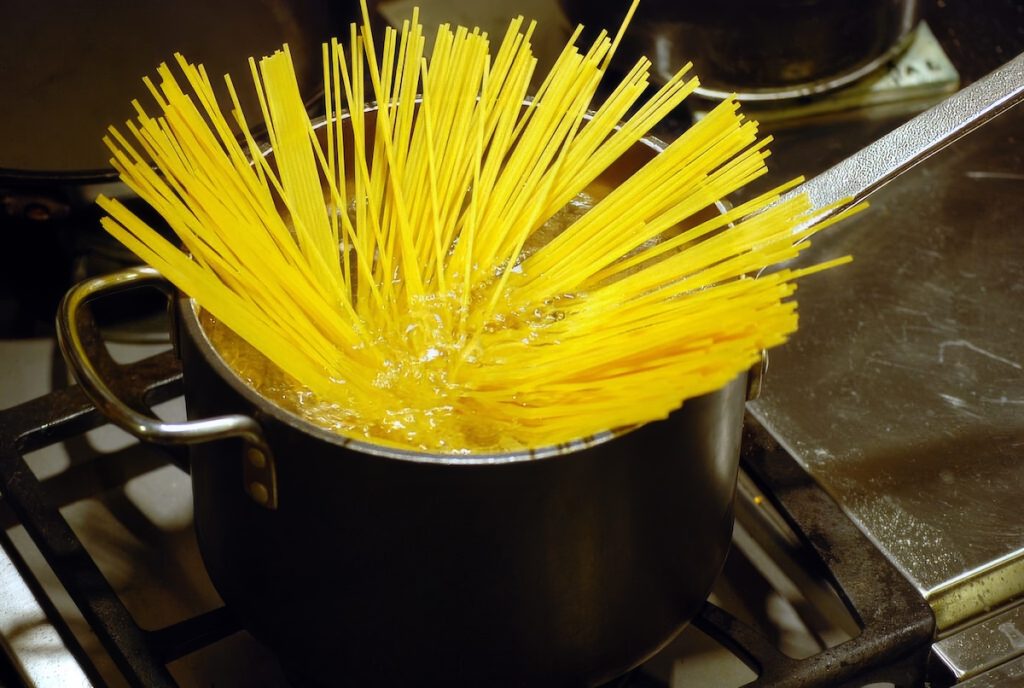
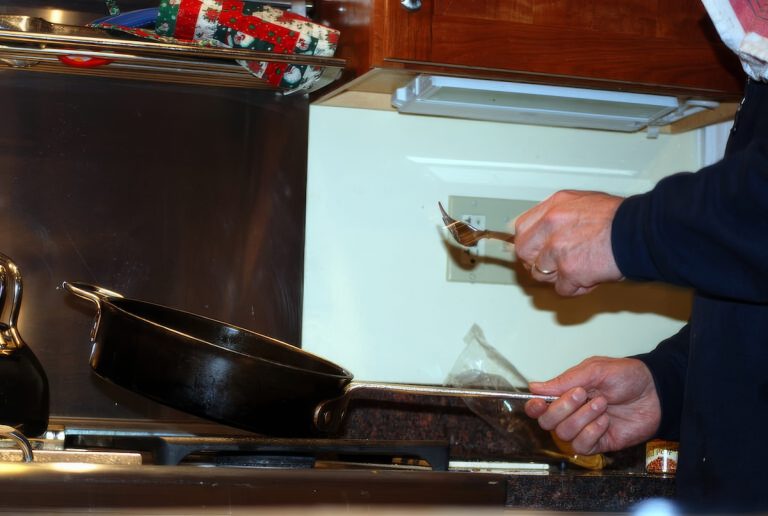
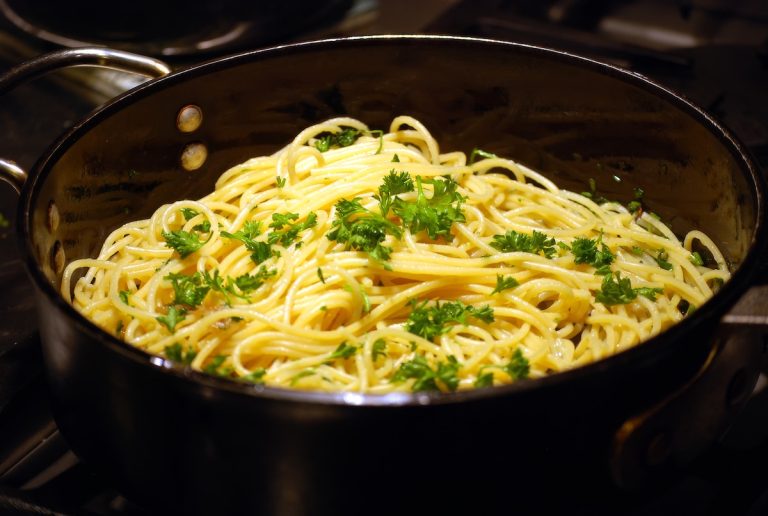

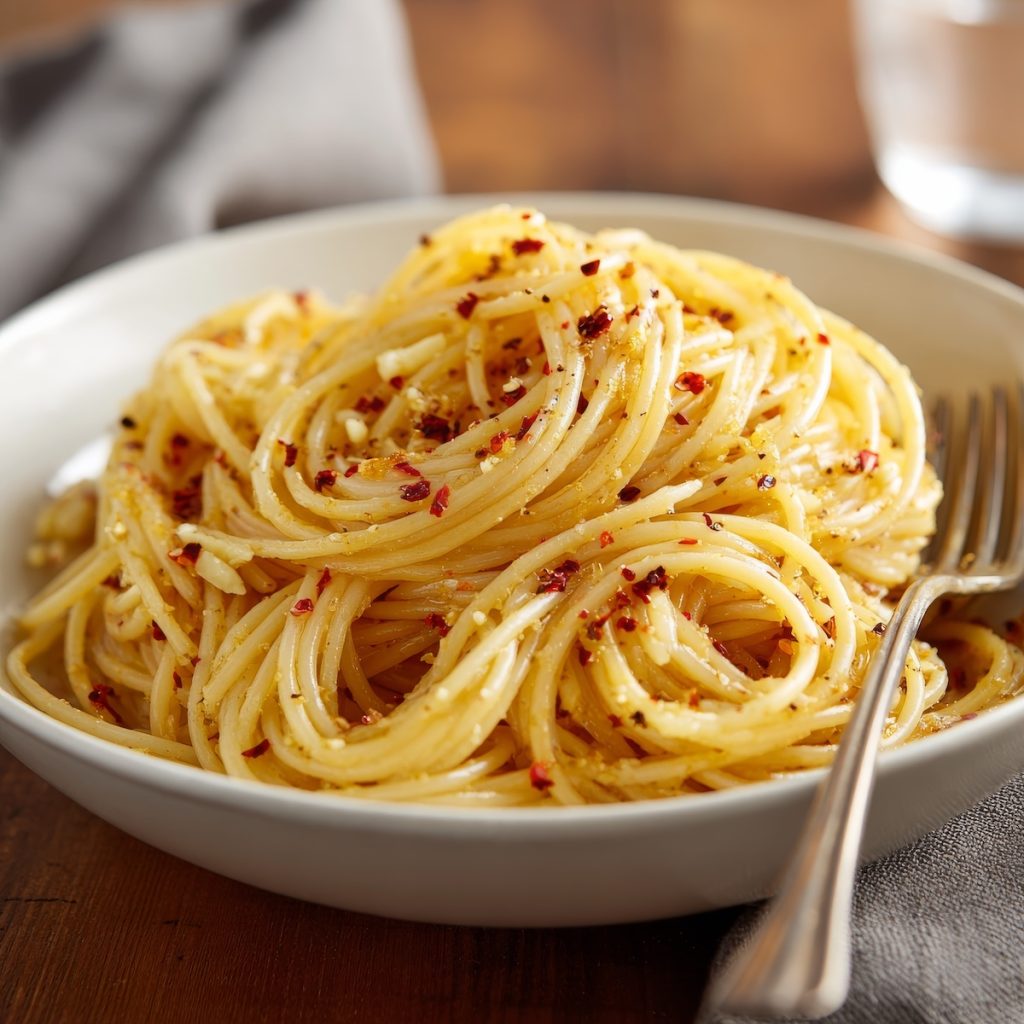
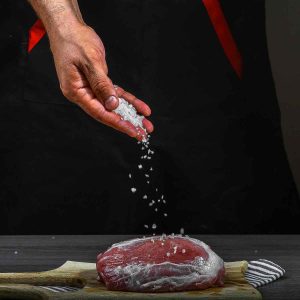
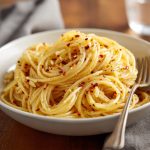
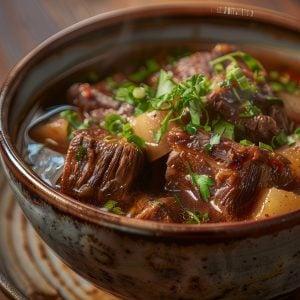
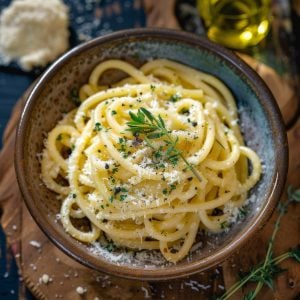
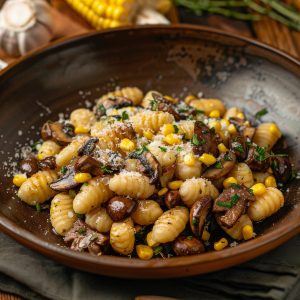
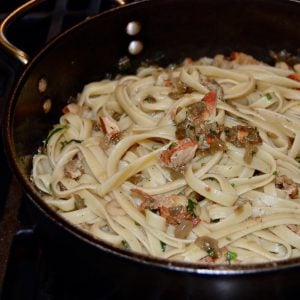
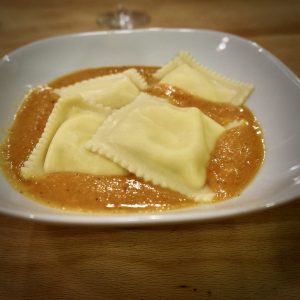


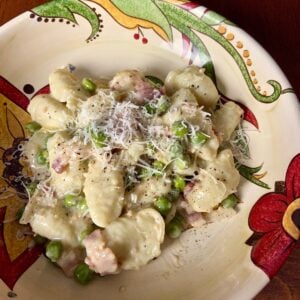


36 Responses
Sounds good to me,just like I remembered it as a child.
I made this dish but added a bit of fresh grated Ramano cheese just before serving. While the pasta was hot sprinkle liberally with the cheese, toss to begin melting and coat. Serve immediately!
This is very tastey and simple. Love it eat it all the time.
I have eaten this dish for many more years I want to remember mr forefathers ,from Italy all loved it ,it was served after wedding parties ,and many other times,as an excuse to enjoy our home made wine,and enjoy each company.found with too much grated cheese it became too heavy . But each to his own taste .
Wonderful ,simple dish to enjoy our Italian heritage
Added onions to oil and garlic, and used fresh basil instead of parsley, and it blended nicely with penne. Was awesome. 🙂
seems that green capsicum ( bell pepper ) sliced thin and long, would go well with this dish too, add a few slices towards the end of the cooking, so that they will be crisp…..maybe it’s worth a try.
Yes! I am going to add green and red bell pepper to this dish!!
The garlic and olive oil is the whole flavor thing about this tasting so wonderful! If you do not have good olive oil, you are wasting your time!
I like to add some mussels steamed with garlic,butter olive oil ,parsley now that good eatting…
This was simple! I added dry basil, fresh lemon, spinach and tomato…so delicious !
My grandmother used to make this all the time for me when I was a kid qith her homemade seasoned breadcrumbs. It gives an interesting texture and flavor to the dish.
Do I need to take the cooked garlic out of the oil before I mix the spaghetti in? The recipe doesn’t say.
No Debi, leave the garlic in.
I don’t have real garlic, only garlic powder. I’m trying to make this, but in a different way since I don’t have garlic. Boil the water with salt, add the noodles (elbow macaroni, all we have), when it’s done I’ll drizzle olive oil over the noodles and shake some garlic on it. Do you think this’ll actually work?
M.M., if that’s all you have on hand, go for it and let me know your results.
Can I use minced garlic from a jar?? If so, how much would equal 4-6 cloves. Thanks
Wonderful recipe. I added finely chopped roasted red bell pepper fresh greek and sweet basil and fresh oregano over herb chicken tortelini. Was very good!
I just made this quite similar but I actually started with some chicken breast strips, seasoned them then added the ingredients to make the sauce in the same deep pan.. I grated the ingredients… garlic, added some fire roasted pepper, red and green pepper, onions.. Baked some fresh bread to wipe up some of the sauce onto…mmm mm, oh yah and added some freshly grated Parmesan Romano cheese.. And I used farfalle, bow ties Delish 🙂
Question for everyone…
My dad has been told by his doctors he can’t have any salt anymore. I see a lot of great Recipes but all call for Salt. What can I replace this with or can I just drop the Salt out? I cook for him once a month on the grill most of the time and food saver it for him. Any help would be great.
Thanks.
Greg
Hi Greg there’s is a product called Mrs.Dash you can usually find it with the spices. It is a salt alternative doesn’t taste exactly the same sprinkled on but cooked you can’t tell the difference
First, the description of ‘sauce’ was used to describe the oil, parsley & garlic topping, if you will.
Second, The therm ‘sauce’ is used to describe the topping on pizzas & vegetables.
What is traditionally served with and pasta, in the Italian households, is called ‘Gravy’.
In northern Italy there is ‘brown’ gravy due to the red meats that are readily available. In southern Italy there is “red’ gravy due to the tomato crops.
Tony, I grew up hearing sauces called “Gravy” in my Italian friends homes. I wonder if that holds true in Italy too. I mean, do you think Italians call their red and brown sauces “Sugo” or is this American slang?
Gravy is a Sicilian term.
Mainland Italians call it Sauce.
gravy is not merely a sicilian term!
gravy is sauce with meat in it
leftovers is called “what-a-gain” in our house. Its the term my beloved grandma used and I think of her when I use it
Italians call their tomato based sauces, those used for pasta, ragu. Hence the product called ragu, which is horrible I might add!
Cooking for one is difficult but of course I could always have leftovers which would be good. Just beginning to cook with fresh garlic. Do I mince it or leave it whole. I have been mincing it and I think I have been doing it wrong. Oregano and basil, but I am stuck with dried. Buying fresh means I throw out a lot. How much dried. I have been making this dish but it seems to need more of everything. Help.
Hi Ellen, this dish really needs to be made with fresh garlic and parsley. Rather than throwing out the fresh parsley, oregano or basil, you may want to try freezing it so you have it when you need it.
I mince it and sometimes I add an Italian deli meat cut up called prosciutto. Yum and Good Luck.
Can I replace the olive oil with coconut oil or would you say they are about the same in good fats!?
Sharmayne, I say give it a try and see how you like it. I would think you are going to get a different end result flavor but if you like it better, who cares? I’m always for substituting different ingredients to find what works for you. I use recipes as guides but often change them around to work with ingredients I have on hand or really like.
I added peeled medium/large fresh shrimp to the garlic oil/water and cooked until pink then added the spaghetti
I’m going to try this today!!! We had pasta and meatballs yesterday for dinner but, Made too much pasta!!! AGAIN! I have to remember now, that when I cook I’m not cooking for 4-5 any longer. However, I’m going to throw in some broccoli and possibly cauliflower! (Looovvveee them two verges) and I think it’ll be a nice additive. I’ll let you all know how we like it! Also will be serving it with garlic bread, (garlic lightly spreaded on Italian bread) and butter.
Sounds like a great meal Debbie.
Tony, sorry but gravy is an American term and sauce for an Italian and by the way I am Sicilian and Napolitano. Lol